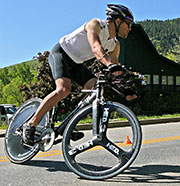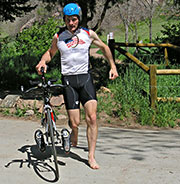How To Nail The Ironman Marathon
How To Nail The Ironman Marathon
By Matt Fitzgerald
The marathon is where Ironman dreams die. It is very difficult to run a strong marathon after riding 112 hard miles, and in fact it is seldom done.
Consider the following example. At the 2008 Ironman Arizona, the fastest bike split was 4:26:12, and the 50th-fastest bike split was 4:55:24—29 minutes and 12 seconds, or 10.9 percent, slower. Compare this gap to the corresponding gap in the run. The fastest run split was 2:46:38, and the 50th-fastest run split was 3:20:22—33 minutes and 44 seconds, or a full 20 percent, slower.
As you can see, in the bike leg, the top 50 times were bunched close together, whereas in the run they were spread out. This pattern is apparent in every Ironman, and it is most certainly not evidence that the depth of running talent is less than the depth of cycling talent in these events. Rather, the pattern is seen as a consequence of the fact that athletes begin the bike leg with fresh legs, and thus most of the strong riders are able to perform at a level that matches their ability. But in the run, which begins with fatigued legs, most athletes fail to compete at a level that matches their ability. They bonk and lose huge chunks of time compared to the few competitors who manage to hold it together through the marathon.
Following are some tips that will help you avoid the all-too-common scenario of running poorly in the Ironman marathon:
Get as strong as you can on the bike The inaugural Ironman Wisconsin, held in 2002, featured a novelty. A couple of elite Kenyan runners did the race. I’m talking about sub-2:15 marathoners. The story was that some coach had recruited these guys as a sort of experiment. Anyway, not only did the poor guinea pigs get crushed on the swim and the bike, but they also ran terribly. This unique example demonstrates that the first key to running strong in an Ironman is not pure running ability but strength on the bike.
The inaugural Ironman Wisconsin, held in 2002, featured a novelty. A couple of elite Kenyan runners did the race. I’m talking about sub-2:15 marathoners. The story was that some coach had recruited these guys as a sort of experiment. Anyway, not only did the poor guinea pigs get crushed on the swim and the bike, but they also ran terribly. This unique example demonstrates that the first key to running strong in an Ironman is not pure running ability but strength on the bike.
It makes sense, right? Your bike fitness has to be at such a level that you can ride hard for 112 miles and still have something left for the marathon. All of the running fitness in the world won’t help you otherwise. How do you get that strong on the bike? The short answer is by putting in a ton of volume. But most of us don’t have enough time to put in the optimal amount of bike miles. So then, what is the least you can do to build enough bike fitness so that 112 miles is no big deal?
Aim to complete four independent 100-mile rides, one pair of back-to-back four-hour rides, and one all-day ride (about eight hours, as slow as you need to go to survive it). All of these rides should occur within the last 10 weeks before your taper, and obviously in the preceding weeks you should gradually build your long-ride distance toward the 100-mile level.
Run long, but don’t run a lot
It may be intuitive to believe that running a lot of miles is an effective means to improve one’s chances of running a strong Ironman marathon, but in fact it is not. While you have to be fit enough to run a strong marathon, you should actually do the minimum amount of running to ensure that you are capable of running a strong marathon and devote any remaining available weekly training hours to building the bike strength that will enable you to actually realize your running potential.
I recommend that even serious competitive Ironman triathletes perform only three independent runs per week. The most important of these is the weekend long run. Complete at least four runs of 18 miles or more, and feel free to go as long as 26.2 miles in training to cement a solid reserve of running endurance. Put as much as you want into your long runs (within reason), but resist the temptation to do any more running during the rest of the week than is required to support your progress in these long runs, as it will only increase your risk of injury and burnout and take away from your cycling.
Do frequent transition runs In Ironman training, a mile run immediately after riding is probably worth five miles run on fresh legs. Running off the bike in training prepares you specifically to run off the bike in an Ironman. I believe that doing short runs frequently off the bike in training is more beneficial than doing occasional longer runs off the bike, because it’s really the transition from cycling to running that you are trying to train. If you can start running strong off the bike, chances are you will continue running strong. And the converse is also true. Unlike in regular marathons, Ironman marathons usually don’t turn ugly at 20 miles. They start ugly.
In Ironman training, a mile run immediately after riding is probably worth five miles run on fresh legs. Running off the bike in training prepares you specifically to run off the bike in an Ironman. I believe that doing short runs frequently off the bike in training is more beneficial than doing occasional longer runs off the bike, because it’s really the transition from cycling to running that you are trying to train. If you can start running strong off the bike, chances are you will continue running strong. And the converse is also true. Unlike in regular marathons, Ironman marathons usually don’t turn ugly at 20 miles. They start ugly.
After building your base, add one easy mile of running after one ride in the week. Then add an easy mile of running after a second ride the next week and continue in this manner until you are running an easy mile after each ride. Next, add a second mile of easy running after one ride, and the following week add one easy mile to another post-ride transition run. Finally, over the ensuing weeks, gradually increase the pace of those two, two-mile transition runs until you’re doing them at roughly your lactate threshold pace.
A second advantage of this approach—the first advantage being its effectiveness—is that it is not terribly stressful. If you ride four times a week, you are looking at a maximum of six miles of transition running, with four of those miles at threshold intensity. Those few miles will do you far more good than they would if incorporated into your training in any other way.
Don’t waste your energy on speed work
Pure runners typically do two fast runs each week. Pure cyclists typically do two fast rides each week. And many triathletes try to do two fast rides and two fast runs each week. I don’t think this is a good idea for anyone, except perhaps World Cup racers. But it’s definitely not a good idea for those training for Ironman events. The problem is that fatigue from cycling transfers all too well to running, and vice versa, such that doing two hard rides and two hard runs weekly is almost tantamount to a pure runner doing four hard runs every week. Fatigue will accumulate and performance in all of those hard workouts will be compromised.
Even for those few athletes who hold it together, the Ironman marathon is run at a relatively low intensity—about 60 percent of VO2 max. While faster runs could theoretically stimulate improvements in aerobic capacity and efficiency that would enhance performance in the low-intensity Ironman marathon, these theoretical benefits are outweighed by the fatigue cost that would come with trying to combine high-intensity run training with high-intensity bike work.
I believe that Ironman triathletes are better off committing to either one or the other, and specifically to high-intensity bike training. Doing two hard rides per week in addition to a long ride will make you that much stronger on the bike and that much more likely to have enough legs left at the start of the marathon to hold goal pace—which, again, is not a particularly fast pace for any triathlete—all the way to the finish. And keep in mind that, just as fatigue crosses over between cycling and running, so does fitness, albeit to a lesser degree. So you can count on those hard rides to also elevate your running a bit.
I am not suggesting that you avoid fast running altogether. But I am suggesting that you strictly limit it. In addition to the threshold-pace transition runs I described earlier, you may also do some Fartlek runs with 30- to 60-second spurts of 5K to 3K race pace running scattered throughout an otherwise steady, moderate-pace run, some very short (8-10-second) hill sprints after you’ve completed one of your weekly easy runs, and progressions, consisting of one to three miles of running at marathon to 10K pace at the end of a base run or long run. That should do it.
Do a metric Ironman As I suggested above, doing frequent, short transition runs off the bike will prepare you to start your Ironman marathon strong, and when you start the marathon strong, you have a good chance of finishing it strong. However, a one- or two-mile transition run does not fully prepare the body for the stress of running an entire marathon after a long, hard ride. Nothing does, actually, but a long bike-run brick workout will help.
As I suggested above, doing frequent, short transition runs off the bike will prepare you to start your Ironman marathon strong, and when you start the marathon strong, you have a good chance of finishing it strong. However, a one- or two-mile transition run does not fully prepare the body for the stress of running an entire marathon after a long, hard ride. Nothing does, actually, but a long bike-run brick workout will help.
Four to five weeks before you race an Ironman, do what I call a metric Ironman. As you know, an Ironman features a 112-mile bike leg and a 26.2-mile run. A metric Ironman workout consists of a 112 km (69.6-mile) bike leg and a 26 km (16.1-mile) run. That’s about two-thirds of what you will have to do on race day, which is about perfect in terms of simulating the Ironman challenge without overtaxing your body. Do both the bike and the run at close to Ironman race intensity. (You can even start with a 2.4 km [1.5-mile] swim if you like.)
Running a marathon off the bike will neither seem nor be quite as hard once you’ve got this metric Ironman workout under your belt.
Don’t banquet on the bike
Many Ironman marathons are ruined by nutritional issues, and nine times out of ten the specific nutritional issue is consuming too much rather than too little. Triathletes very often overestimate both the amount of nutrition they need to get through an Ironman and the amount their bodies can actually absorb and use.
If you can take in 60g of carbohydrate and 750ml of fluid per hour on the bike, which is very easy to do with nothing more than a sports drink, you should be fine. Few athletes can absorb and use more than 80g of carbs per hour. If you’re a bigger athlete and your race takes place on a hot day, you may need 1.0 to 1.2 liters of fluid per hour to prevent a dehydration-related slowdown. But 80g of carbs per hour and 1.0 to 1.2 liters of fluid per hour are still a lot less than many triathletes try to cram down.
The rub is that the body can absorb a lot more fluid and carbohydrate during cycling than during running, due to the stomach jostling involved in the latter. So what happens is that competitors take in as much nutrition as their bodies can handle on the bike, then hop off and start running only to be hit with nausea, bloating and worse. So be careful not to overdo your nutrition intake in the last hour of the bike leg, so your GI system won’t declare mutiny at the start of that all-important marathon.
Matt Fitzgerald, is a journalist and author specializing in the topics of health, fitness, nutrition and endurance sports training. His work appears regularly in publications such as Runner's World, Triathlete, Her Sports and Running Times. He has also authored and coauthored numerous books, including Triathlete Magazine's Complete Triathlon Book, which has sold more than 60,000 copies since its publication in 2003. In addition, he has designed numerous training plans for runners and triathletes. Learn more at www.TrainingPeaks.com.
